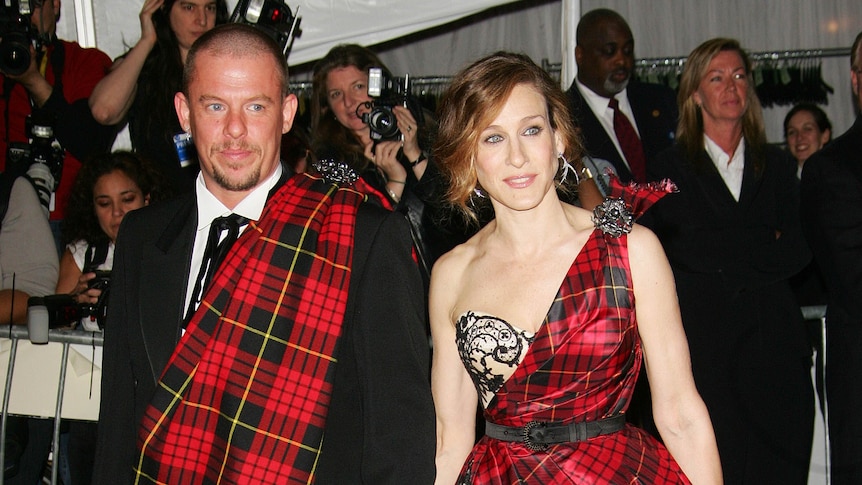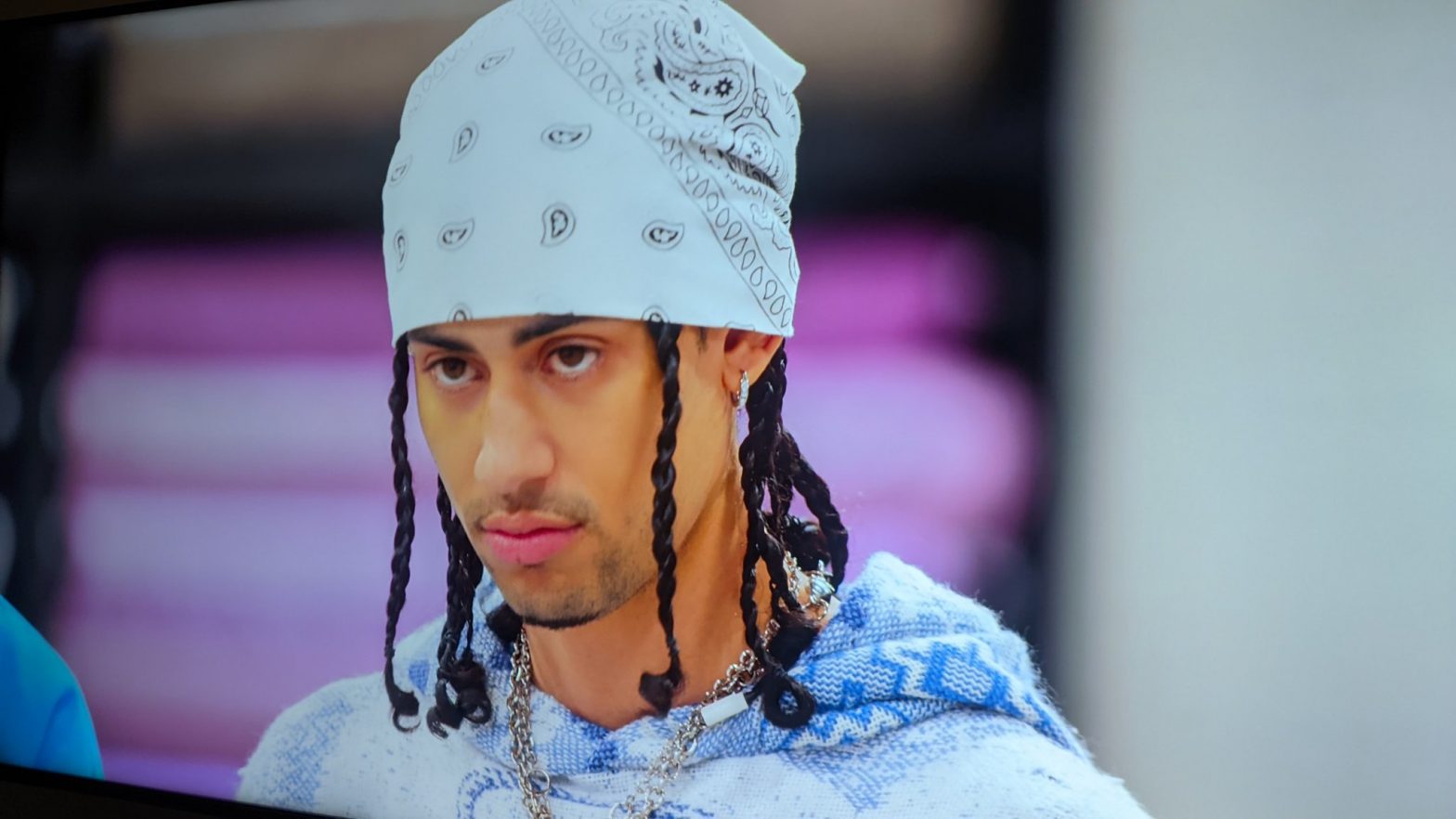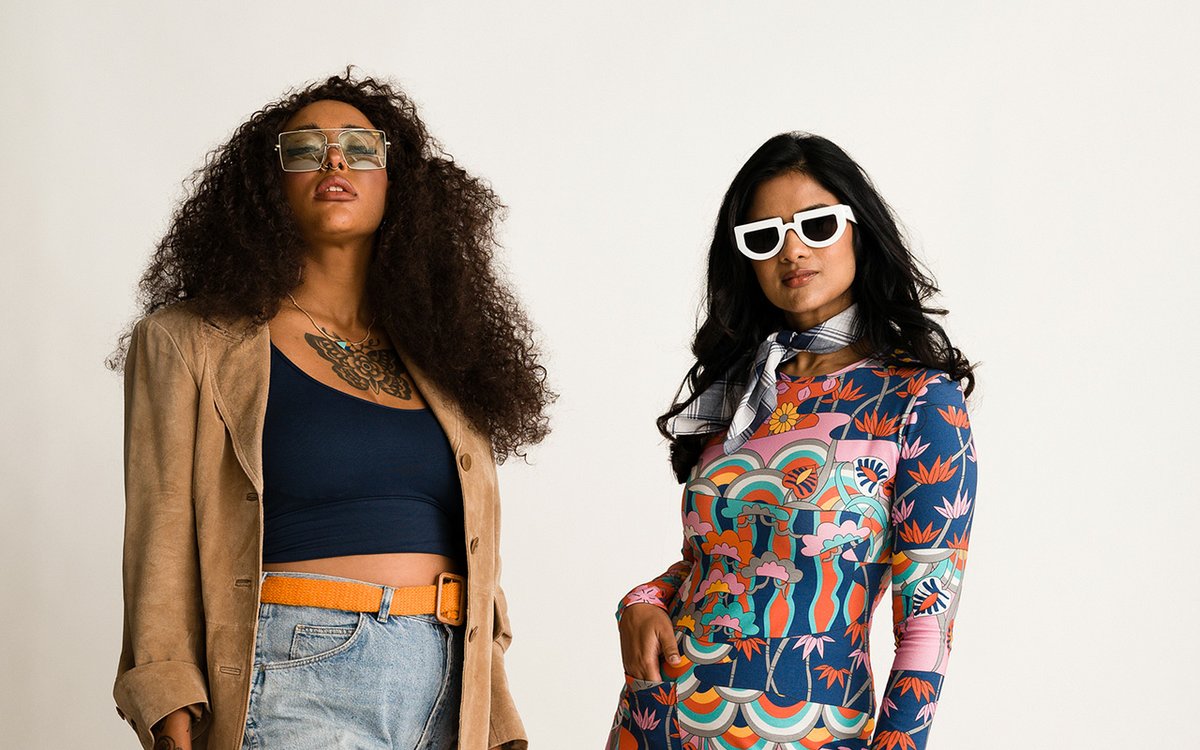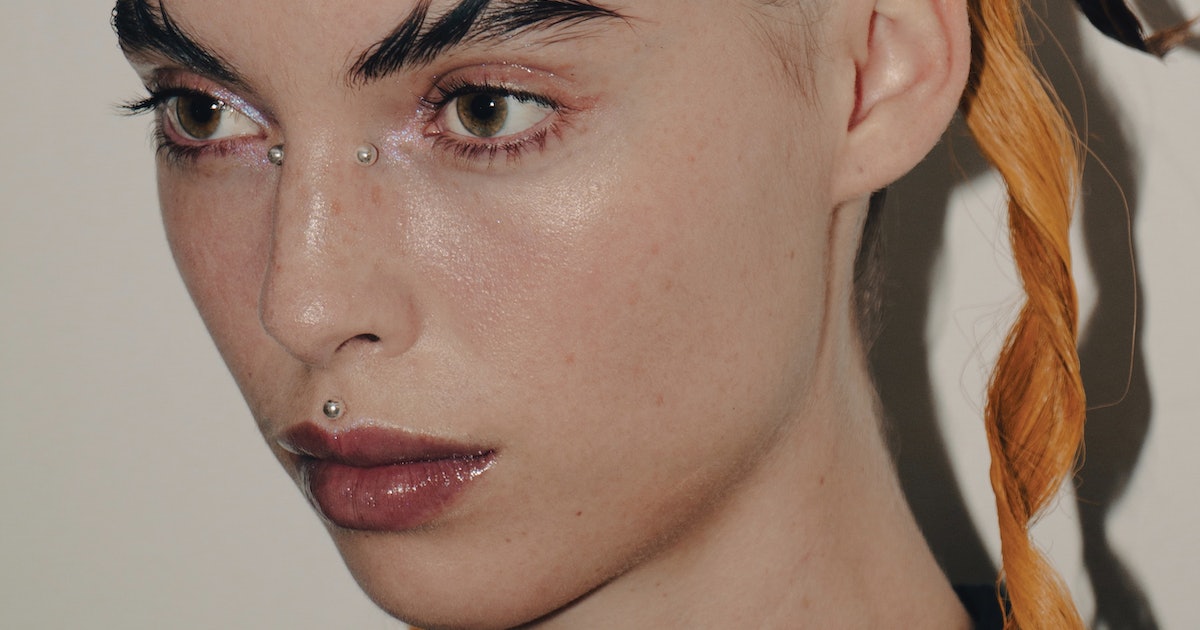[ad_1]
Where the fashion cosmos is dominated by names with the longevity of comets — from Coco Chanel and Christian Dior to Karl Lagerfeld and Vivienne Westwood — Alexander McQueen was more of a shooting star, his career cut short by his suicide in 2010, aged 40.
At that point, he had created 36 collections for his own label across 18 years — not including his work at Givenchy, where he was appointed head designer in 1996 (a mere four years after he graduated from the fashion program at London’s Central Saint Martins College).
The Givenchy years cemented him as an international rockstar of fashion — feted by Vogue, worn by celebrities including Madonna and David Bowie, and headhunted by Gucci creative director Tom Ford, with the company buying a majority stake in McQueen’s label in 2000.
Of course, McQueen’s cheeky approach with the British press and spectacle-driven shows (rings of fire, snowstorms, sprinkler-drenched catwalks) didn’t hurt when it came to building a profile — nor did his rags-to-riches origin story: a self-described “working-class kid” and son of a cab driver who got his start as a 16-year-old apprentice on London’s high-end tailoring strip, Savile Row, and celebrated his East End roots as he rose through fashion’s ranks.
McQueen was also riding the wave of the Cool Britannia movement, alongside Oasis, the Spice Girls, Damien Hirst, Austin Powers and Ministry of Sound.
But most importantly, his work was exceptional.
This is abundantly evident in a new exhibition at the National Gallery of Victoria (NGV), featuring more than 120 garments and accessories alongside runway footage and backstage photography, and a series of artworks that point to the designer’s eclectic influences.
Alexander McQueen: Mind, Mythos, Muse reveals McQueen as a unique and virtuosic artist, a deep thinker, and a storyteller for whom clothes were just one tool to enact expansive, ambitious visions.
The exhibition, at NGV until April 16, is a collaboration with the Los Angeles County Museum of Art (LACMA), bringing together works from both institutions’ permanent collections with a handful of private loans from McQueen’s friends and collaborators.
Mind, Mythos, Muse is self-consciously styled as a different offering from the landmark McQueen retrospective Savage Beauty, which was hugely popular when it opened at New York’s Metropolitan Museum of Art in 2011, and broke records at London’s Victoria & Albert Museum (V&A) in 2015, selling more than 480,000 tickets.
Where Savage Beauty offered a comprehensive, biographical view of the designer’s work, drawing on private and institutional collections from around the world, this new exhibition was conceived as a showcase specifically of NGV and LACMA’s collections — spurred by recent major donations of McQueen garments to each museum by private collectors.
“LACMA is an encyclopaedic art museum that holds works from all over the world, different time periods and mediums — and McQueen was an encyclopaedic artist, drawing inspiration from all over the world, different time periods and mediums,” explains Clarissa Esguerra, associate curator of costume and textiles at LACMA, which instigated the project.
“So [we thought], ‘What if we contextualised his work within art history?'”
The curators initially tested their concept with a dress from McQueen’s 2003 collection Scanners, which took Japanese fashion history as its key inspiration and premiered with a runway show that traced a story of migration from the Arctic tundra of Siberia, through Tibet, into Japan.
“We had this dress — we were looking at the geometric pattern in the fabric, and we were like, ‘What is this pattern? Can we identify it? Does it have significance?'” Esguerra recalls.
A detective hunt led them to kati rimo: “[It’s a] pattern that’s very important to Tibet, because it was used as a Buddhist textile. And that textile motif moved to Japan with Buddhism,” says the curator.
“So [we realised that] he’s telling the story of migration and fashion drawing on textile history — and our minds were blown. We were like, ‘Oh my God, can we figure this out with other objects?'”
‘An encyclopaedic artist’
McQueen sometimes wore his influences on his sleeve: Garments in Mind, Mythos, Muse feature reproductions of artworks by late-medieval artist Hieronymus Bosch, Italian Futurist photographer Wanda Wulz, and Dutch graphic artist M.C. Escher.
There were many explicit cinema references, too, with collection titles such as Supercalifragilisticexpialidocious, Taxi Driver and The Man Who Knew Too Much.
Other key inspirations included the natural world, in particular birds, butterflies and aquatic life; and history — familial and colonial.
Breakout ‘moments’ within the NGV exhibition showcase his final full collection, 2010’s Plato’s Atlantis, which riffed on the patterns and silhouettes of sea creatures; 2007’s In Memory of Elizabeth Howe, Salem, 1692, inspired by McQueen’s ancestry; and 2006’s The Widows of Culloden, which, like his 1995 collection Highland Rape, was a commentary on England’s brutal military campaigns in 18th-century Scotland, and also inspired by his ancestry.
The development of each collection began with an “extraordinary amount of research”, says Catherine Brickhill, who was hired by McQueen (known to friends and colleagues by his first name, Lee) in 1996, as his first design assistant.
“It could come from so many diverse sources … People who work in fashion often use clothing as a reference point — you’ll go to a flea market, pick up a vintage piece and use that as inspiration, or [use] a magazine tear,” she explains.
“[But] we weren’t really doing that with McQueen. Often they were concepts that were quite hard to translate into clothing.”
Brickhill worked with McQueen during his Givenchy years, and says the team would raid the Galignani bookshop in Paris, where the design house had an account, buying up beautiful art books.
Nafisa Tosh, who started with McQueen as a tailor in 2005 — deep into his well-funded ‘Gucci years’ — says he had a massive personal reference library: a gallery-sized room with books, CDs, DVDs and videos, floor to ceiling.
“Most designers, they perhaps have two, three, four, up to six points of reference that the collection would be based on … With Lee, he had maybe 25 or 35 points of reference, and they all intermingled and overlapped,” Tosh marvels.
“You would get this incredible creative explosion.”
The Widows of Culloden collection exemplified this, she says: “You’ve got layers on layers of references, fabrics, techniques, pattern cutting, construction.”
Brickhill echoes Tosh: “I think there are very few people perhaps who have that many reference points [and] that many different interests.
“And Lee was [also] exceptional because he had such an amazing photographic memory … he’d see something once, then it was stored on the hard drive.”
Peeling the layers of the onion
The density and diversity of reference points that made McQueen’s collections so unique and fascinating presented a unique challenge for the LACMA and NGV curators.
They worked across departments, with curators in fashion and textiles drawing on the expertise of colleagues with other specialisations, to identify reference points and then find works within the museums’ collections that might tease these out for audiences.
The resulting imbrication of art, artefact and fashion doesn’t so much replicate McQueen’s references as approximate them in broad brushstrokes: The exhibition doesn’t include the original artworks that McQueen reproduced on garments, or even necessarily the specific works he was referencing, but instead offers comparative works and approximations.
Instead of a Hieronymus Bosch, for example, we get a (rather striking) macabre 16th-century religious painting by his lesser-known Dutch contemporary, Jan Mandyn.
To illustrate the Ancient Greek and neoclassical reference points in McQueen’s 2006 collection Neptune, we are presented with 19th-century revival caryatids from the facade of a Parisian hotel, a Derby porcelain figure of Neptune, and Jacques-Antoine Beaufort’s 18th-century painting The Oath of Brutus, among other works.
To identify reference points for each garment, the curators also leaned heavily on the knowledge of avid collector and enthusiast John Matheson, proprietor of the Instagram account McQueen Vault, who consulted on both the LACMA and NGV iterations of the exhibition.
Matheson, an American who moved to the UK in 2012, started collecting McQueen memorabilia in 1996, after seeing footage of the designer’s runway show for the Dante collection on TV. He now presides over a massive, unofficial archive that includes physical ephemera (show invitations, photographs, magazine clippings), catalogues, lookbooks, clothing and accessories.
Having immersed himself in McQueen’s world over decades — and then followed his career in real time from 1996 to 2010 — Matheson is a human ‘bible’ for McQueen’s inspirations, having combed through the designer’s own words.
He describes “peak McQueen” as collections where “you’ve got so many layers of an onion, you can peel back and keep on being fascinated by every element of it”.
For NGV, he was charged with doing deep, granular research into the 50-or-so garments within the museum’s collection (the vast majority donated by champion fashion benefactor Krystyna Campbell-Pretty in recent years).
“I tried to find things that directly quote his voice, and not necessarily reviews, so that the authenticity is held intact, and it really is him speaking,” Matheson says.
Master craftsman
When you ask fashion insiders what sets McQueen apart, they universally point to his technical virtuosity; this was a designer who could walk the talk.
“If Lee was talking about something and I couldn’t understand it, he would jump on the sewing machine and he would show me,” says Nafisa Tosh.
“The majority of designers that I’ve worked with before and since don’t have that level of expertise.”
It came from an array of experiences: He learned the fundamentals of tailoring on Savile Row, and refined them working for Japanese designer Koji Tatsuno and then Italian designer Romeo Gigli; early on, he expanded his technical and aesthetic repertoire working as a pattern cutter for theatrical costumiers Angels & Bermans.
“[Learning] how to do so many different layers of tailoring … allowed him to tear everything up and do it in his own way,” says Tosh.
“There hasn’t been anyone else with his background in tailoring before or since, who has this level of creativity.”
It is perhaps a hard story to tell — and skill set to demonstrate — in an exhibition; but NGV gamely attempts it in a section titled Technique and Innovation, focusing on garments that demonstrate his penchant for deconstruction, interest in Western costume history, and experimentation with surface treatments.
It contains a ‘toile’ (work in progress) dress made by Tosh for the Widows of Culloden collection, using actual fabric rather than the usual calico. It may look innocuous to a viewer, but it reveals McQueen’s confidence in his designs.
“With most designers, you work with the flat pattern — so you start with a fashion drawing, and then it’s worked out [as a flat pattern]. And then you cut it out in a calico [fabric], create it, and then you draw on the calico — like, I want more volume here, or less,” Tosh explains.
“But with Lee, you just went straight to [the finished] fabric.”
She points to an elaborate dress from the Widows of Culloden collection: “So for this — there was no pattern, we created this [in 3D].”
Runway visionary
For Matheson, The Widows of Culloden collection, from which 12 looks are showcased at NGV, is a perennial favourite: “It is peak McQueen … every single look, every single girl, every single garment that comes out, music, lights, production, everything — it was absolutely flawless.”
McQueen’s runway shows represented the apotheosis of his elaborate visions, and his clothes are best understood in the context of these narratives, which were typically crafted via elaborate sets, props, lighting and sound design.
The NGV exhibition attempts to give a sense of the runway presentations: Footage from more than a dozen shows is concentrated within a neon-lit L-shaped corridor between gallery spaces, alongside backstage photography by British fashion photographer Robert Fairer, showing decked-out models either posing or candid — and often mid-prep, with McQueen team members ministering to their outfits.
Footage from the Widows of Culloden show can be found in this section, alongside short clips from McQueen’s graduate collection, Jack the Ripper Stalks His Victims (1992); and Voss (2001), a harrowing, asylum-themed show that opened with his audience looking at their own reflections in a mirrored stage box for an hour before curtain rise, and closed with an electrifying coup de theatre in which a glass box on stage shattered — releasing a cloud of moths, and revealing writer Michelle Olley reclining nude, wearing a gas mask.
Elsewhere in the exhibition, a standalone moment is given to the stunning finale sequence from McQueen’s 1999 show No. 13, in which two industrial robots apply black and acid-yellow spray-paint to a dress worn by former ballerina Shalom Harlow as she rotates — apparently overwhelmed — on a turntable. (McQueen said the sequence was inspired by German artist Rebecca Horn’s 1991 installation High Moon, featuring rifles and blood).
The second-biggest single-collection display is dedicated to Deliverance (2004), inspired by Sydney Pollack’s 1969 psychodrama They Shoot Horses, Don’t They?, which is set against the backdrop of the Depression-era ‘dance marathon’ craze in America.
In screens above the mirrored display, footage from Pollack’s film is intercut with excerpts from McQueen’s frenetic, emotional runway show, featuring choreography by Michael Clark.
(Keep an eye out, earlier in the exhibition, for a haunting photograph taken by Robert Fairer runway-side, showing an exhausted-looking Karen Elson being carried off stage on the back of a male dancer in the finale of the show).
McQueen wasn’t alone in the theatricality of his runway presentations — his British contemporary John Galliano was comparable in his showmanship, for example. But no-one was doing shows with the “bite” or that “deeper message”, says Fairer.
“I think there’s a lot of smoke and mirrors when it comes to fashion … [but] I don’t think the staging [in McQueen’s runway presentations] was to do with enhancing the clothes — they didn’t need it. The clothes were beautiful, and technically phenomenal.”
Matheson describes McQueen’s runway shows as, above all, autobiographical: “It was his story. It’s who he is. It’s where he was from. It’s his experiences.”
This is borne out by McQueen’s own statements about his work being an embodiment of himself.
“And I think that’s one of the really compelling things about him: It’s all there for you to look at and see,” says Matheson.
“And for someone to share such emotion and creativity and insight into their thought process and creative workings, that’s an incredibly personal thing to do. And it makes absolute sense that so many of his shows are so emotional — because of that.”
Alexander McQueen: Mind, Mythos, Muse is on at NGV International, Melbourne, until April 16.
[ad_2]
Source link



